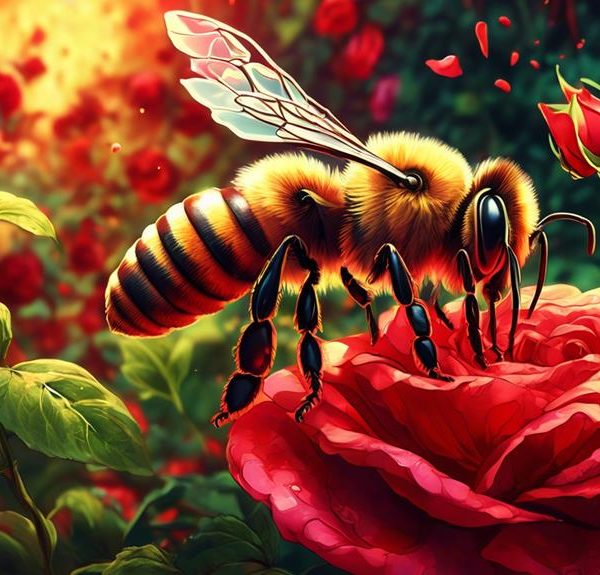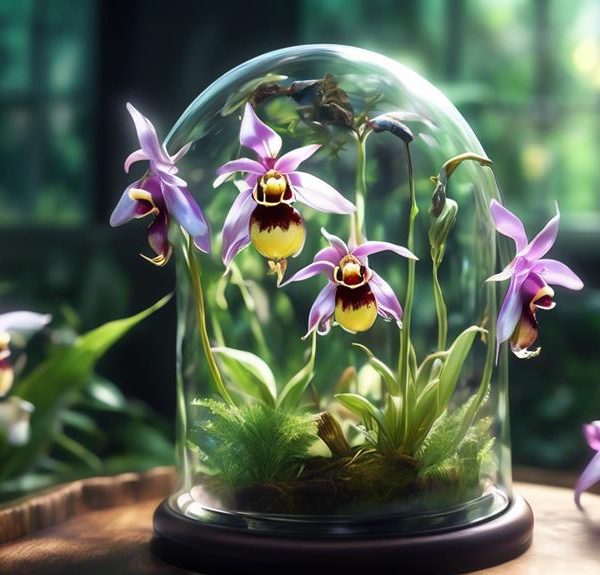Learn about the intriguing rarity of Bee Orchids in the UK, their unique relationship with bees, and the environmental factors affecting their distribution.

Are Bee Orchids Rare in the UK?
You've probably heard the theory that Bee Orchids are rare in the UK, but how much truth is there to this?
Sure, they're not the type of plant you'll stumble upon in every garden or public park, but they are known to pop up in some unexpected places.
Their rarity partly comes from their unique pollination process, which involves a rather specific relationship with bees.
But there's more to the story than just that. Intrigued? There's a whole world of botanic intrigue and environmental factors to explore that could shed more light on this issue.
Key Takeaways
- Bee orchids are adaptable to a range of habitats in the UK, including chalk and limestone grasslands, sand dunes, and roadside verges.
- Habitat loss due to urban development and modern farming practices is a major threat to bee orchid populations.
- Changes in specific bee species populations directly impact the reproduction of bee orchids.
- Bee orchids are currently classified as 'Least Concern' by the IUCN, but their population in the UK has been declining due to habitat loss.
Understanding Bee Orchids
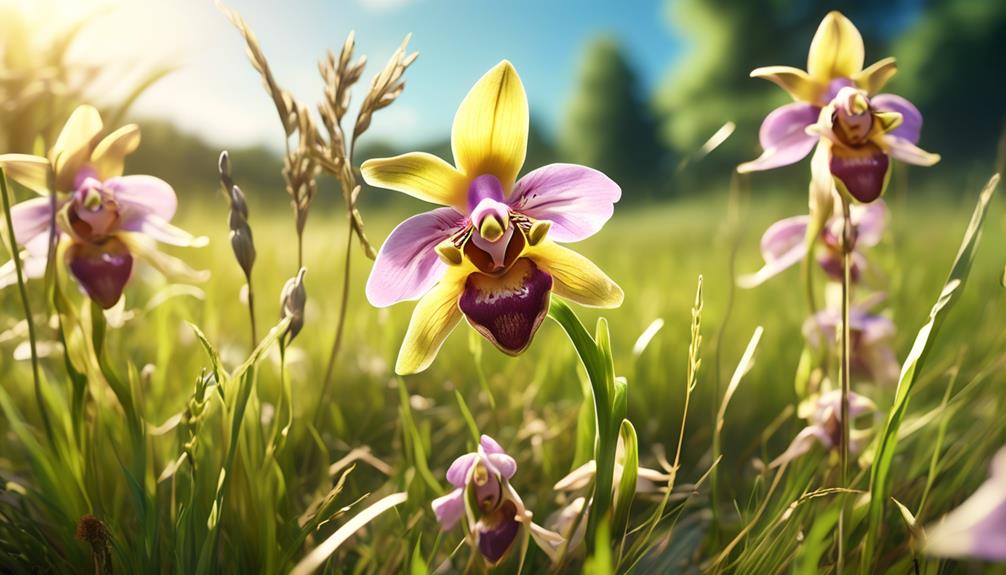
Often, you'll find bee orchids strikingly mimicking their pollinators, not only in appearance but also in scent, a fascinating example of evolutionary adaptation in the plant kingdom. This intriguing resemblance, termed as pseudocopulation, is a strategic play to attract male bees, convincing them they've found a potential mate. It's a clever ruse, encouraging the bees to attempt mating and subsequently assisting in the orchid's pollination.
You might wonder how this mimicry extends beyond visual deception. Well, bee orchids emit volatile compounds that closely resemble female bee pheromones, adding another layer to their disguise. Research reveals that they even mimic the tactile feel of a female bee. This intricate deception is what makes these plants so successful in their reproduction.
However, these adaptations aren't static. They're a product of an ongoing evolutionary process, subject to change based on pollinator behavior. If bees start recognizing the deceit and avoid the orchids, the plants may evolve different strategies. Understanding bee orchids requires an appreciation for this dynamic interaction, a testament to nature's ingenuity and adaptability.
Bee Orchids Distribution in the UK
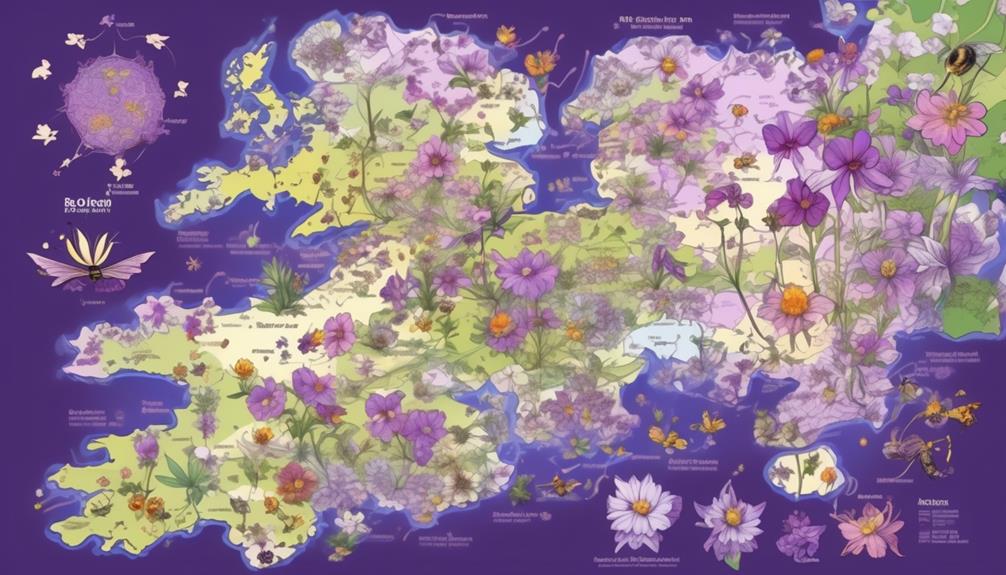
In the UK, you'll find bee orchids spread across a range of habitats, from chalk and limestone grasslands to sand dunes and roadside verges, demonstrating their adaptability to various environmental conditions. This wide distribution is a testament to their resilience and versatility, although they do show a preference for alkaline soils.
To give you a clearer picture, here is a table showing the typical habitats and corresponding distribution percentage:
Habitat | Distribution % |
|---|---|
Chalk and limestone grasslands | 45% |
Sand dunes | 30% |
Roadside verges | 15% |
Others (Urban areas, abandoned quarries, etc.) | 10% |
Despite their widespread distribution, the bee orchid population in the UK is under threat due to habitat loss and climate change. It's important to note that while they're widely distributed, they're not necessarily abundant in these areas. Monitoring and conservation efforts are essential for ensuring their continued presence in the UK's diverse habitats. Understanding their distribution is a crucial step in forming effective conservation strategies.
Factors Affecting Bee Orchids Population
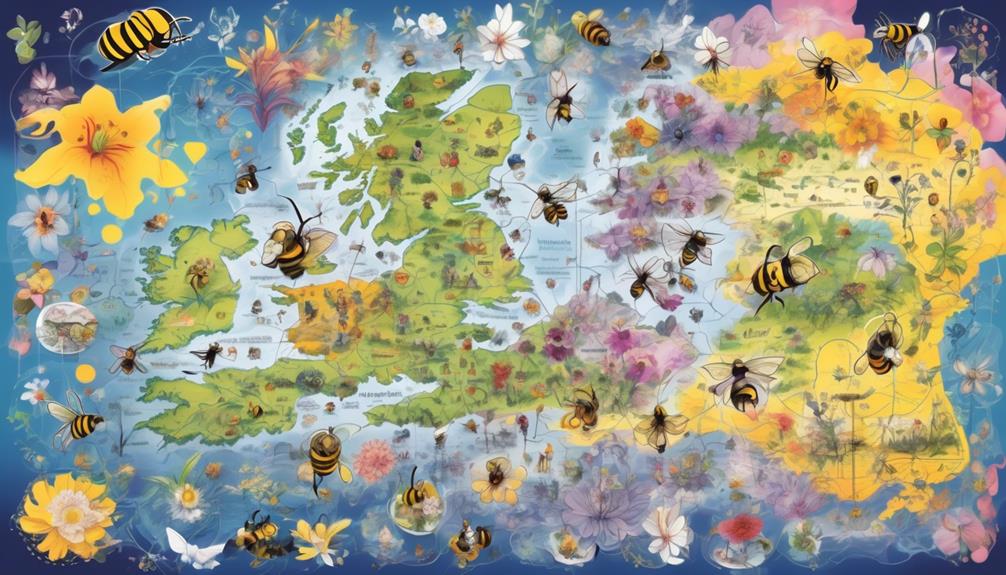
While you may find bee orchids in various environments across the UK, several factors significantly impact their population numbers, from the destruction of their natural habitats to shifting climate conditions.
Urban development and modern farming practices often lead to habitat loss, a major threat to their survival. These activities eliminate the grasslands and meadows the orchids thrive in, reducing their numbers dramatically.
Climate change also plays a significant role. With rising temperatures, the UK's weather patterns become more unpredictable. Orchids, being sensitive to such changes, may not adapt quickly enough, leading to population decline. Moreover, the bee orchids' unique pollination strategy relies heavily on specific bee species. Changes in these species' populations, due to factors such as disease or habitat loss, directly impact the orchids' ability to reproduce.
Lastly, the collection of orchids by enthusiasts can contribute to their rarity. Despite legal protections, illegal harvesting still occurs. It's crucial to understand these factors, as they hold the key to conserving this fascinating species.
Bee Orchids Conservation Status
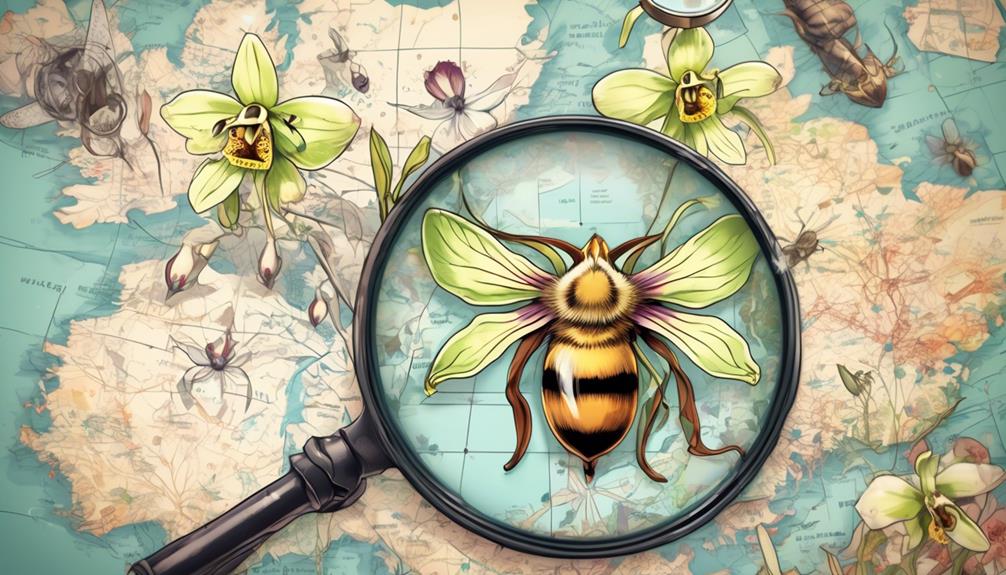
Given the various threats facing bee orchids, you might be wondering about their current conservation status in the UK. As per the data from the International Union for Conservation of Nature (IUCN), bee orchids aren't currently classified as endangered or threatened. However, they're labelled as 'Least Concern', which doesn't mean they're devoid of risks.
You should be aware that this status is primarily due to the plant's widespread distribution across Europe. It's noteworthy that their population in the UK has been declining, predominantly due to habitat loss from agricultural intensification, urban development, and improper land management.
The UK Biodiversity Action Plan recognises bee orchids as a species of principal importance. As a result, it's subject to conservation efforts aimed at preserving its habitats and preventing further population decline. These include statutory site protection, habitat restoration, and land management practices that favour the growth of bee orchids.
You'd also find it interesting that their deceptive pollination strategy, mimicking female bees to attract male bees, plays a crucial role in their survival. So, while bee orchids aren't officially endangered, they're certainly a conservation priority in the UK.
Impact of Climate Change on Bee Orchids
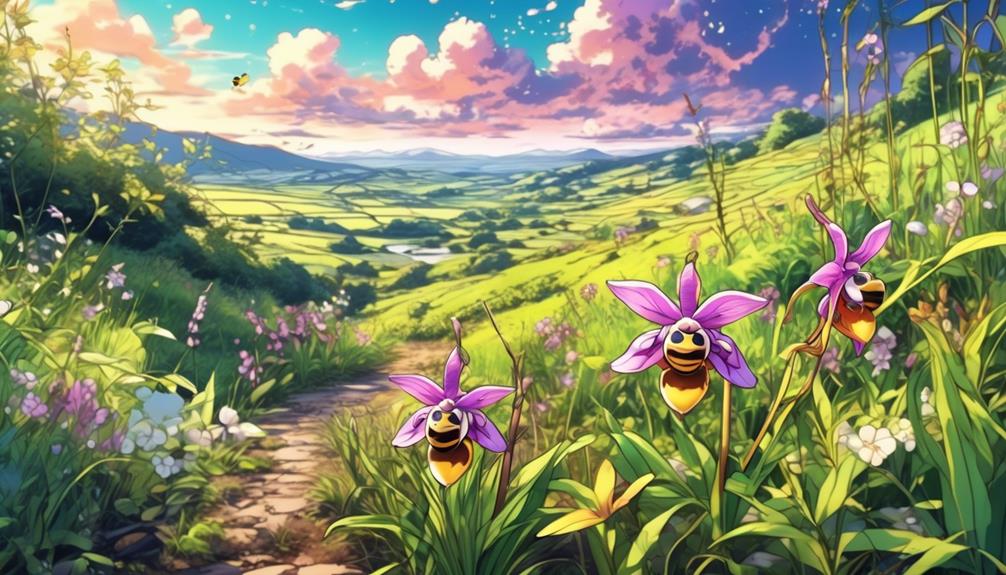
Surprisingly, climate change may be affecting bee orchids' survival and distribution patterns in the UK. Global warming is causing shifts in weather patterns, leading to milder winters and hotter summers. This type of climate flux can cause bee orchids to bloom earlier, potentially missing their pollinators' active periods.
You might be aware that bee orchids rely on specific weather cues to commence their growth cycle. An increase in average temperatures can disrupt this timing. When plants bloom out of sync with their pollinators, it's known as phenological mismatch. It's a serious issue, as it can lead to reduced pollination success, lower seed production, and eventually, population decline.
Furthermore, climate change can result in habitat shifts. The orchids' preferred habitats may become unsuitable due to changing conditions. This forces the species to migrate to cooler regions, which mightn't be ideal for their growth.
In essence, the climate crisis isn't just a human issue. It's also a pressing concern for the UK's bee orchids. It's crucial for us to understand these impacts and work towards mitigating them, to ensure the survival of this unique plant species.
Encouraging Bee Orchids Growth in the UK

Despite the challenges posed by climate change, there are effective strategies that can encourage the growth and propagation of bee orchids in the UK.
Firstly, you can contribute to their conservation by creating suitable habitats. This involves maintaining areas of unimproved grassland and ensuring that these aren't subject to excessive mowing or grazing which can damage the plants.
Additionally, active seed dispersal can help bolster bee orchid populations. This technique involves collecting seeds from healthy plants and scattering them in areas where the species is struggling to survive.
Scientific research also plays a critical role. You could support or participate in studies aimed at understanding the orchid's biology and ecology. This knowledge can then be used to develop more effective conservation strategies.
Lastly, raising awareness about the plight of the bee orchid is crucial. You might consider promoting their importance to biodiversity and the unique role they play in our ecosystem.
Whilst it's true that climate change presents a significant threat, it's clear that with the right approach, you can make a real difference in preserving and enhancing the UK's bee orchid populations.
Frequently Asked Questions
What Are the Main Predators of Bee Orchids in the Uk?"
In the UK, bee orchids don't face many predators. They're largely left alone due to their deceptive looks, which mimic bees. However, you'll find that slugs, snails, and some insects may nibble on their leaves.
The bigger threat they face is habitat loss. As people develop land, they're losing their homes. That's why it's so important to protect their natural habitats.
How Does the Pollination Process Occur in Bee Orchids?"
You're asking about the pollination process of bee orchids. It's quite fascinating!
Bee orchids produce flowers that mimic female bees in appearance and scent. Male bees, fooled by this mimicry, attempt to mate with the flower.
In the process, they inadvertently pick up pollen, which they'll then transfer to the next 'female' (flower) they visit.
This trickery is how bee orchids ensure their pollination – a brilliant example of nature's ingenuity.
What Are the Common Diseases That Afflict Bee Orchids?"
Bee orchids can be afflicted by several diseases. You'll often see fungal infections, like root rot, caused by overwatering.
Pests, such as aphids and scale insects, can harm them too.
Viral diseases, though less common, can also affect bee orchids. They may lead to color breaking in the flowers.
What Are the Uses of Bee Orchids in Traditional Medicine?"
You're asking about the medicinal uses of bee orchids.
Traditionally, some cultures use these plants as remedies for various conditions. They're believed to have antimicrobial, anti-inflammatory properties, and they're often used in managing menstrual disorders.
However, it's important to note that scientific evidence supporting these uses is limited, so it's best not to rely solely on bee orchids for treatment without consulting a healthcare professional.
Are There Any Cultural or Historical Significances Attached to Bee Orchids in the Uk?"
In the UK, bee orchids don't carry much cultural or historical significance. They're appreciated for their attractive appearance, but they aren't linked to any specific traditions or historical events.
It's more their rarity and unique survival strategies that fascinate botanists and nature lovers. So, while you might stumble upon a bee orchid on a summer walk, you won't find it woven into UK's cultural tapestry.
Conclusion
In essence, bee orchids aren't exactly rare in the UK, but numerous factors, including habitat loss and climate change, are impacting their numbers. These peculiar plants are now under the UK's conservation radar.
Encouraging their growth requires a deep understanding of their needs and distribution. So, it's on us to implement effective conservation strategies, ensuring these fascinating flowers continue to add to the UK's rich biodiversity.

